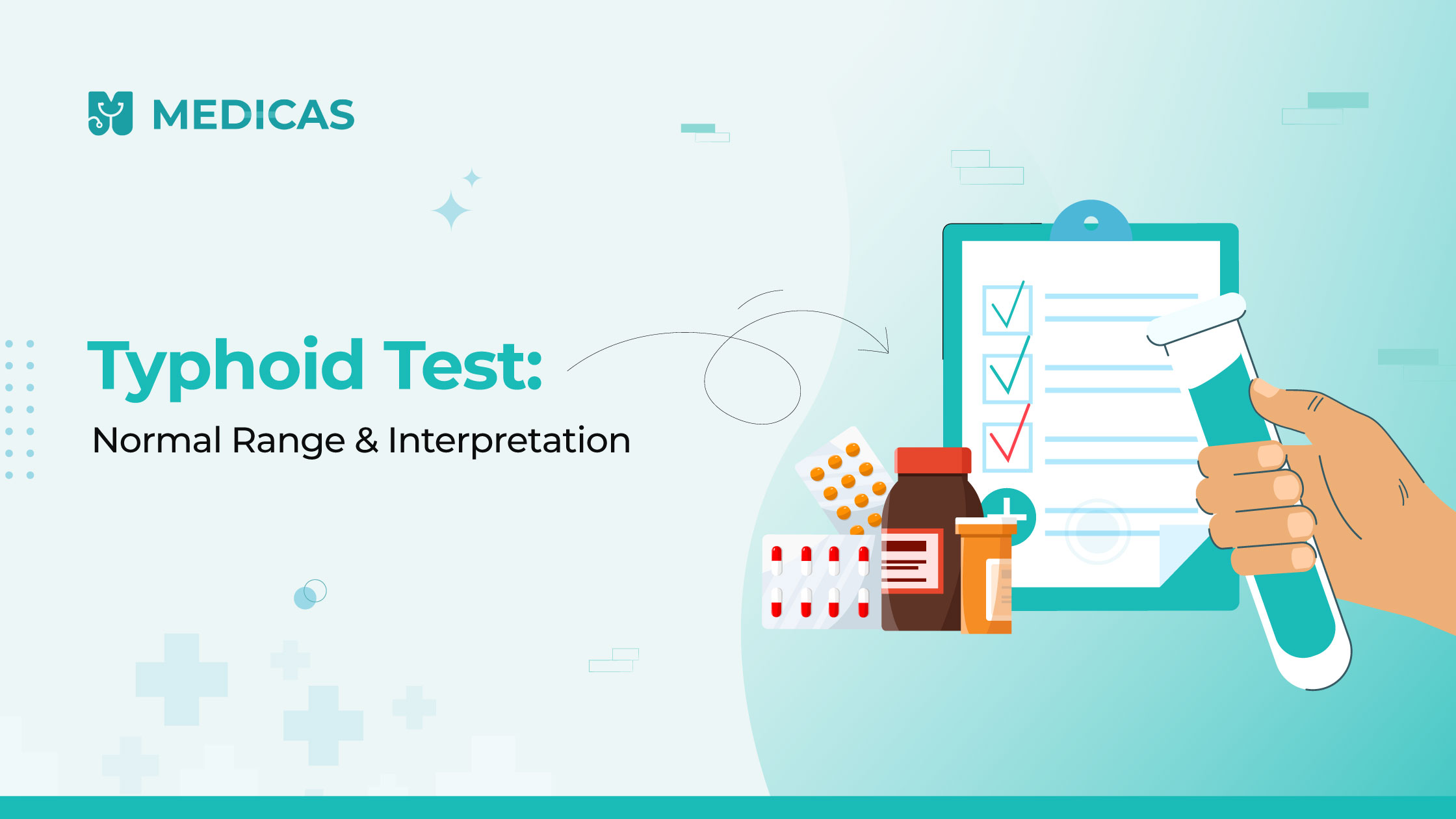Typhoid fever is a bacterial infection caused by Salmonella typhi, commonly transmitted through contaminated water or food. It is a major public health concern in developing countries and can lead to life-threatening complications if not diagnosed and treated promptly. This is why accurate testing and timely interpretation of your typhoid test report is critical. As a General Practitioner (GP), I often encounter patients confused about their typhoid test interpretation. In this guide, I’ll walk you through the types of typhoid tests, what the normal range means, how to read your Widal test report, and when to consult a doctor based on your results. If you’re experiencing symptoms or already have test results in hand, you can consult a GP online or book an appointment through Medicas. You can also book a lab test to confirm a diagnosis.
What Is a Typhoid Test?
A typhoid test is a laboratory diagnostic procedure that helps confirm the presence of Salmonella typhi or paratyphi bacteria in the body. These bacteria infect the intestines and bloodstream, often leading to high fever, abdominal pain, and gastrointestinal symptoms. Several diagnostic tests are available, each with varying sensitivity and specificity. The most commonly used tests include:
- Widal test
- Typhidot (IgM/IgG) test
- Blood culture (gold standard)
Understanding the typhoid test normal range and report interpretation is essential to avoid misdiagnosis or overtreatment.
Why Is Typhoid Testing Important?
Typhoid shares symptoms with several other illnesses like malaria, dengue, or viral fever, especially in tropical regions. Accurate testing:
- Helps initiate timely antibiotic treatment
- Prevents complications like intestinal perforation or sepsis
- Helps control the spread in households or communities
- Avoids unnecessary antibiotic use
Because the initial symptoms are non-specific, a typhoid diagnosis test is often recommended when fever persists beyond 3–4 days.
Common Symptoms That Require Typhoid Testing
Symptoms that typically prompt a doctor to order a typhoid blood test include:
- Persistent high-grade fever (>102°F)
- Weakness and fatigue
- Abdominal pain or discomfort
- Headache and loss of appetite
- Constipation or diarrhea
- Rash (rose spots on the abdomen)
These symptoms, combined with a travel history or poor hygiene exposure, make testing imperative.
How Typhoid Spreads
Typhoid is a classic example of a fecal-oral route disease:
- Consuming contaminated water or food
- Poor hand hygiene
- Using shared toilets without sanitation
It spreads rapidly in overcrowded areas or during monsoon. Preventing it through safe water, clean food, and hand hygiene is just as critical as diagnosing it correctly.
Types of Typhoid Tests
Widal Test
The Widal test detects agglutinating antibodies (O and H) in the patient’s serum against Salmonella typhi. It’s widely used in resource-limited settings, though not always highly specific.
- TO antigen (Typhi-O): Indicates active infection
- TH antigen (Typhi-H): Indicates past exposure or immunity
- AO and AH: For S. paratyphi A and B
Limitations:
- May give false positives in people vaccinated for typhoid
- May be unreliable in early infection (<5 days of fever)
Typhidot Test
This rapid test detects IgM and IgG antibodies specific to Salmonella typhi. It’s useful because:
- IgM appears early (acute infection)
- IgG appears later (past infection or recovery)
It offers faster results and better specificity than Widal in many cases.
Blood Culture Test
The gold standard for typhoid diagnosis. Blood cultures involve:
- Drawing blood before starting antibiotics
- Growing the bacteria in a culture medium
It may take 48–72 hours but offers definitive diagnosis. However, its accuracy declines once antibiotics are started.
Normal Range for Typhoid Test
Widal Test Normal Range Values
Widal test results are expressed in titres. The normal value depends on endemicity of typhoid in the region, but generally:
- TO antigen <1:80 = normal
- TH antigen <1:160 = normal
- Titres above 1:160 or rising in repeated samples indicate probable infection
It’s important to test paired samples 7–10 days apart to confirm rising titres, rather than relying on a single value.
IgM and IgG Test Normal Values
- IgM negative: No current infection
- IgM positive: Suggests current/recent infection
- IgG negative: No past exposure
- IgG positive: Past infection or vaccination
Typhoid IgM and IgG test result interpretation depends on timing. A positive IgM with symptoms supports acute infection, while a positive IgG alone may not need treatment.
Interpreting Your Typhoid Test Report
What a Positive or Negative Result Means
- Positive Widal test (with high titres): Indicates possible typhoid but must be correlated clinically.
- Negative Widal: Doesn’t rule out typhoid, especially in early stages
- Positive IgM/IgG: Helps pinpoint the stage of infection
- Positive culture: Confirms active infection
Borderline Typhoid Results: What Should You Do?
Borderline titres (e.g., 1:80) may be seen in:
- Past vaccination
- Carrier states
- Other febrile illnesses
In such cases:
- Repeat the test after 5–7 days
- Combine with clinical evaluation
- Consider a blood culture or CBC
Also consider a routine pathology panel to rule out concurrent conditions.
When to Consult a Doctor Based on Your Results
You should consult a doctor if:
- Fever persists >3 days
- Typhoid titres are borderline or rising
- You’re already on antibiotics but not improving
A GP can guide treatment, duration of antibiotics, and retesting. Book an online doctor consultation today if unsure.
Typhoid Test Report Sample & Reading Guide
Your report may look like this:
| Test | Result | Reference Range |
| Widal TO | 1:160 | <1:80 |
| Widal TH | 1:320 | <1:160 |
| Typhidot IgM | Positive | Negative |
| Typhidot IgG | Negative | Negative |
In this case, the report suggests active typhoid infection. Doctors often use this in combination with a CBC (to check WBC count) and liver function tests.
Common Misinterpretations in Typhoid Testing
- “Any positive Widal = typhoid” – Not always true
- Early negative results rule it out – False, especially within 3 days of symptoms
- Positive IgG = infection – No, it may be from old exposure or vaccine
Always correlate test results with symptoms and repeat if needed. Self-medicating with antibiotics based on a borderline report is risky.
How Long Does It Take to Get Results?
- Widal test: Same-day or within 24 hours
- Typhidot: Usually within 24 hours
- Blood culture: 48–72 hours (may take longer)
Fasting is not required for typhoid testing. For general prep, see Fasting Before a Blood Test: Everything You Need to Know
What to Do After a Positive Typhoid Test
After confirmation:
- Begin antibiotics as prescribed
- Monitor fever and hydration
- Isolate for 2–3 days to avoid spreading
Home remedies like ORS, boiled rice water, and rest can aid recovery. Avoid spicy, oily food.
When to Repeat the Typhoid Test
Repeat testing may be needed:
- If symptoms persist despite treatment
- If culture was negative initially
- To confirm clearance in chronic carriers
Doctors may recommend repeat cultures 1–2 weeks after antibiotics.
Online Consultation for Typhoid Symptoms
Booking a Typhoid Test Through Online Doctor Services
With telemedicine, it’s easy to:
- Book a home collection lab test
- Share your results with a doctor
- Get prescriptions without visiting a clinic
Use Medicas Lab Booking or consult a GP directly.
Preventing Typhoid: Do’s and Don’ts
| Do’s | Don’ts |
| Drink clean, boiled, or bottled water | Eat from roadside vendors or drink untreated water |
| Wash hands thoroughly with soap and water | Ignore symptoms lasting more than 3 days |
| Get vaccinated before travel to endemic areas | Neglect basic food and personal hygiene |
Vaccines provide partial protection. Maintaining hygiene is equally important.
Diet and Hydration Tips During Recovery
| Eat | Avoid | Hydrate |
| Soft-cooked rice, bananas, applesauce, curd, boiled vegetables | Spicy food, raw vegetables, dairy (if intolerant), fried food | ORS, coconut water, clear soups |
Learn more from What to Eat and What Not to Eat in Typhoid
Conclusion
Understanding your typhoid test interpretation can prevent delays in treatment and reduce complications. Whether you’ve taken the Widal test, Typhidot, or a blood culture, knowing the normal range and what’s considered positive is essential. As a GP, I recommend always correlating reports with symptoms and seeking medical advice when in doubt. You can consult me online or book a lab test directly from home.
Frequently Asked Questions (FAQs)
- What is the normal range for a typhoid test? Widal TO <1:80 and TH <1:160 are typically considered normal. For Typhidot, negative IgM and IgG indicate no infection.
- How can I interpret my widal test report? A titre of >1:160 (TO) and >1:320 (TH) often suggests current or recent infection, especially if symptoms match.
- Can I book an online doctor consultation for typhoid symptoms? Yes, you can book an online consultation for interpretation, prescriptions, or treatment guidance.
Is it possible to get a typhoid test online through a telehealth platform? Yes, with Medicas, you can book a lab test and have samples collected from home.
Disclaimer
Medical Advice: The information provided in this blog post is for educational purposes only and should not be considered as a substitute for professional medical advice, diagnosis, or treatment. Always consult with a qualified healthcare professional for personalized guidance regarding your specific medical condition.
Accuracy of Information: While we strive to provide accurate and up-to-date information, the field of medicine and viral fevers is constantly evolving. The content in this blog post may not reflect the most current research or medical guidelines. Therefore, it is advisable to cross-check any information provided with reliable sources or consult a healthcare professional.
Individual Variations: The symptoms, causes, treatment options, and preventive measures discussed in this blog post are general in nature and may not apply to everyone. It is important to remember that each individual’s situation is unique, and personalized medical advice should be sought when making healthcare decisions.
External Links: This blog post may contain links to external websites or resources for additional information. However, we do not endorse or have control over the content of these third-party websites. Accessing these links is done at your own risk, and we are not responsible for any consequences or damages that may arise from visiting these external sources.
Results May Vary: The effectiveness of treatment options or preventive measures mentioned in this blog post may vary from person to person. What works for one individual may not work the same way for another. It is essential to consult with a healthcare professional for personalized advice tailored to your specific needs.

Dr. Aesha Bhatt is a dedicated General Physician with over 4 years of clinical experience in delivering comprehensive primary care. Based in Vadodara, Gujarat, she holds an MBBS degree and is registered with the Gujarat Medical Council. Dr. Bhatt is committed to providing holistic, evidence-based medical care, with a focus on managing common acute and chronic conditions. Known for her patient-first approach and strong diagnostic acumen, she is passionate about preventive healthcare, patient education, and building long-term trust with those she serves.


